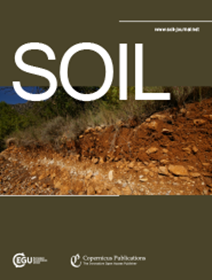Soil organic carbon mineralization is controlled by the application dose of exogenous organic matter
IF 5.8
2区 农林科学
Q1 SOIL SCIENCE
引用次数: 0
Abstract
Abstract. Substantial input of exogenous organic matter (EOM) may be required to offset the projected decline in soil organic carbon (SOC) stocks in croplands caused by global warming. However, information on the effectivity of the EOM application dose in preserving SOC stocks is surprisingly limited. Therefore, we set up a 90 d incubation experiment with large soil volumes (sandy loam and silt loam) to compare the mineralization of EOM (13C-labelled ryegrass) and SOC as a function of three EOM application doses (0.5, 1.5, and 5 g dry matter kg−1 soil). The percentage of mineralized EOM was expected to increase linearly with a higher EOM dose in sandy loam soil and to level off in silt loam soil due to the limited O2 supply in order to maintain aerobic microbial activity. In the sandy loam soil, the percentage of mineralized EOM was not affected by EOM dose, while SOC mineralization increased proportionally with an increasing EOM dose (+49.6 mg C g−1 EOM). Likewise, the formation of microbial biomass carbon was proportional to EOM dose, suggesting no reduction in microbial growth efficiency at a higher C concentration. In the silt loam soil, a decreasing tendency in the percentage of mineralized EOM was apparent but could not be confirmed statistically. We therefore conclude that, as in the sandy loam, the proportion of EOM mineralization was not affected with an increasing EOM dose, while SOC mineralization increased at a higher rate than in the sandy loam soil (+117.2 mg C g−1 EOM). Consistently with this lack of response in the proportion of EOM mineralization to EOM dose, soil EH did not decrease with an increasing EOM dose, indicating no O2 limitations. In both soils, an increasing EOM dose possibly supplied energy for microbial growth and enzyme production, which, in turn, stimulated mineralization of native SOC (i.e. co-metabolism). The observed stimulation of soil macroporosity at higher EOM doses in the silt loam soil might have contributed to sustaining the aerobic conditions required for SOC mineralization. In sum, this experiment and our previous research suggest that EOM mineralization is mostly independent of EOM dose, but EOM dose modulates the mineralization of native SOC. Provisional C balances compared to unamended controls indicated that, at low doses, less C remained than when EOM was added at normal or high doses in sandy loam soil, while no effect was found in silt loam soil. These findings tentatively indicate that using larger EOM doses could help preserve more added EOM-C, but longer-term confirmation in the field will firstly be required before we can draw any conclusion for soil C management.土壤有机碳矿化受外源有机质施用剂量的控制
摘要。由于全球变暖导致农田土壤有机碳储量下降,可能需要大量的外源有机质(EOM)输入来抵消。然而,关于EOM应用剂量在保存SOC存量方面的有效性的信息却令人惊讶地有限。因此,我们在大土壤体积(砂质壤土和粉质壤土)下进行了90天的培养实验,以比较EOM (13c标记黑麦草)的矿化和有机碳随EOM施用剂量(0.5、1.5和5 g干物质kg - 1土壤)的变化。矿化EOM的百分比在砂质壤土中随着EOM剂量的增加而线性增加,而在粉质壤土中由于氧气供应有限而保持好氧微生物活性而趋于平稳。在砂壤土中,EOM矿化百分比不受EOM剂量的影响,而SOC矿化随EOM剂量的增加呈比例增加(+49.6 mg C g−1 EOM)。同样,微生物生物量碳的形成与EOM剂量成正比,表明在较高的C浓度下微生物的生长效率没有降低。在粉壤土中,矿化EOM的比例有明显的下降趋势,但不能从统计学上证实。因此,我们得出结论,与砂壤土一样,EOM的矿化比例不受EOM剂量增加的影响,而有机碳矿化的增加速度高于砂壤土(+117.2 mg C g−1 EOM)。与EOM矿化比例对EOM剂量的响应不一致,土壤EH没有随着EOM剂量的增加而降低,表明没有O2限制。在这两种土壤中,增加的EOM剂量可能为微生物生长和酶生产提供能量,这反过来又刺激了天然有机碳的矿化(即共代谢)。在粉壤土中观察到的高剂量EOM对土壤宏观孔隙的刺激可能有助于维持有机碳矿化所需的好氧条件。综上所述,本实验和我们之前的研究表明,EOM矿化在很大程度上与EOM剂量无关,但EOM剂量可以调节天然有机碳的矿化。临时碳平衡与未添加的对照相比表明,在低剂量下,在砂壤土中保留的碳比在正常或高剂量下添加EOM时少,而在粉壤土中没有发现影响。这些发现初步表明,使用较大的EOM剂量可以帮助保存更多添加的EOM-C,但在我们得出土壤C管理的任何结论之前,首先需要在现场进行更长期的验证。
本文章由计算机程序翻译,如有差异,请以英文原文为准。
求助全文
约1分钟内获得全文
求助全文
来源期刊

Soil
Agricultural and Biological Sciences-Soil Science
CiteScore
10.80
自引率
2.90%
发文量
44
审稿时长
30 weeks
期刊介绍:
SOIL is an international scientific journal dedicated to the publication and discussion of high-quality research in the field of soil system sciences.
SOIL is at the interface between the atmosphere, lithosphere, hydrosphere, and biosphere. SOIL publishes scientific research that contributes to understanding the soil system and its interaction with humans and the entire Earth system. The scope of the journal includes all topics that fall within the study of soil science as a discipline, with an emphasis on studies that integrate soil science with other sciences (hydrology, agronomy, socio-economics, health sciences, atmospheric sciences, etc.).
 求助内容:
求助内容: 应助结果提醒方式:
应助结果提醒方式:


